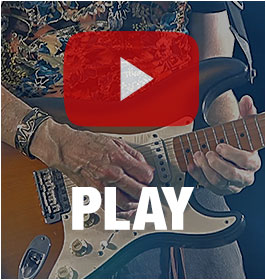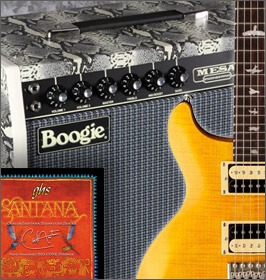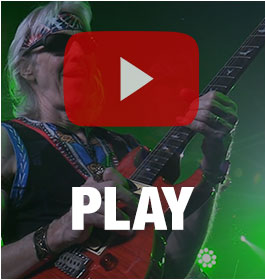While a guitarist’s tone is shaped, in great part by his playing style, his equipment forms an integral part as well. In particular, Carlos Santana’s amplifiers, guitars, and effects combined to create the warm, singing tone for which he is renowned.
Guitar, Guitars, Guitars
The first link in the “signal chain,” an electric guitar is a unique piece of equipment. It lives in both the acoustic and the electronic world, translating a player’s hand motions into an analog signal. As such, a player chooses a guitar both for it’s “feel,” and for it’s tone.
For his earliest albums, Carlos chose a Gibson Les Paul Special Guitar, first with P-90 pickups, and later with standard Humbuckers. The P-90 pickups were closer to the single-coil pickups created in the ’40s than those used later on Fender Strats and Teles.
This instrument is quite close in tonality to the Gibson SG Guitar, with which he is most often pictured on stage during that period.
Note: The SG is an unusual instrument. While it looks cool, the fret-board is stiff, the balance is awkward (take your hands off the axe and its headstock falls toward the ground), and the sound is limited. However, the double cutaway on the SG does allow access to the topmost frets, although with only 22, the highest note accessible (without bending) is a “D” two octaves above middle “C.” This may have affected the choice to play many of the early songs in the keys of “G” and “D.”
The Les Paul Special was far from a top of the line guitar, and did not have the beefy richness or warm sustain of the more expensive Deluxe and Custom models. However, it was, in part, those very shortcomings which helped Carlos create the uneven, raw sound which powered his early years. By using the volume control as an on-board signal adjuster, Santana injected a sense of dynamics into his playing which, combined with his passionate phrasing, gave him a signature edge.
For the third album, Santana (often called Santana III, Carlos had switched to using a Gibson Les Paul Standard, as well as an SG with humbucking pickups. You can hear a bit more meat in his tone, although he hadn’t yet achieved the warm, singing sustain for which he became known.
By 1977, Santana’s main guitar was a Yamaha SG2000, also with a double cutaway body style, which gave him the necessary access to the highest frets. This guitar, in particular, could be considered — in conjunction with the Mesa Boogie amps (see below) — the beginning of the famed “Santana” tone, with it’s smooth roundness, even sustain, and thick tonal quality. (Although he is often said to have played the Yamaha SG175, that was the original Yamaha model from which the SG2000 was developed by Carlos and Yamaha together.)
This signature sound first achieved prominence on 1977’s Moonflower, a combination of live and studio tracks that was Santana’s last commercial success until the 1999 release of Supernatural. Carlos played the Yamaha fairly steadily for about five or six years, until 1982.
Upon discovering Paul Reed Smith in the late ’70s, Santana began using a custom PRS model, and by the early ’80s, it had become his primary instrument. Though Carlos has played several different models over the last few decades, they have all been similar, including double-cutaway bodies, 24 frets, and humbucking pickups.
Amplifiers That Boogie
Back in the late ’60s, the primary amplifiers in use were Marshalls and Fenders. While both had interesting qualities, neither delivered the smooth, tone-rich distortion and sustain that guitarists craved. The only way to improve their performance was to have them modified. Thus Jerry Garcia (Grateful Dead), Mike Bloomfield and others had their amplifiers worked on in order to get a more pleasing tone.
First the first two albums, Carlos Santana used a Fender Twin Reverb, turned all the way up. It is likely that the amp was modified (including the switch to an Altec speaker) to create more gain, yet still didn’t provide as much sustain as he would have liked. To compensate, Carlos would use several techniques, including: 1) cranking the guitar’s volume control at the end of notes; 2) turning the guitar towards the amp to generate feedback; and 3) doubling some of the held notes (in the studio) to add thickness.
But in 1970, an engineer named Randall Smith took out the guts of a Fender Princeton and installed circuitry designed to produce the maximum gain.
When Carlos heard the souped up amplifier, he cried: “Man, that little thing really Boogies!” Thus, the Mesa/Boogie brand name was born. For more than five decades, Santana has continued to use the amplifiers. It is only recently that he has incorporated Dumble amplifiers into his gear. He uses a Jim Dunlop Amp Switcher to move back and forth between those two models, as well as a Fender Twin Reverb. (And, in true Santana style, varies his choices from night to night.)
Sound Effects
Preferring to get his sound from humbucking pickups and an over driven tube amp, Santana employs effects sparingly. His current pedal board includes a Mu-Tron Volume/Wah Wah pedal that he has used for nearly his entire career, as well as an Ibanez Tube Screamer (added much more recently, and used very rarely), and an Ibanez Modulation Delay.
Though it’s hard to detect effects on most of the Santana albums, he has sometimes used a particular technique where he finds a spot within the Wah Wah pedal’s range that he likes, then leaves it there. This is especially evident on Abraxas’ instrumental ballad, “Samba Pa Ti.”
In addition, there are other examples of him using the Wah Wah in a more conventional fashion, such as passages from “She’s Not There,” “Soul Sacrifice (Head, Hands and Feet,” and “Dance Sister Dance (Baila Me Hermana),” all from Moonflower.



